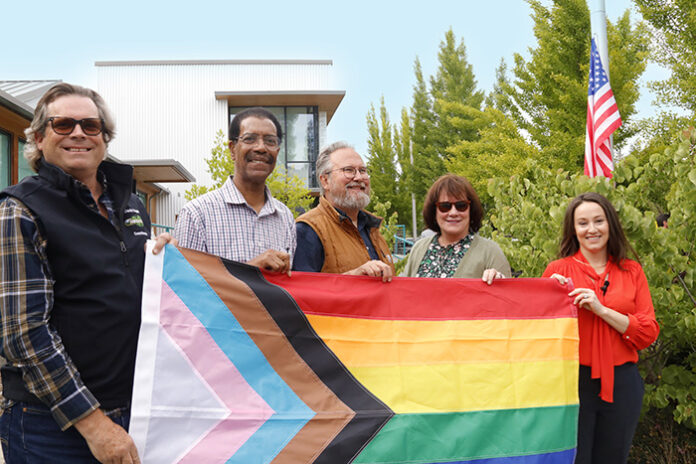
The Healdsburg City Council gathered for the first of its two meetings in June, during which the council is tasked with a number of key measures to keep things on track for their goals and city management over the summer. The council and much of city staff traditionally takes off the month of July as a summer break.
Just prior to the June 5 meeting, however, all five council members and a healthy assembly of interested residents gathered outside Council Chambers for the raising of a multi-hued flag to recognize Pride Month in Healdsburg.
Mayor Ariel Kelly read from the city’s proclamation—officially presented in the meeting that followed, where it was read out by Vice Mayor David Hagele—saying “Healdsburg’s colorful LGBTQIA+ (Lesbian, Gay, Bisexual, Transgender, Queer, Intersex, Asexual and Ally) communities represent an integral part of our community and enhance our city’s well-being…”
The multi-colored nature of the community is symbolized by the Pride Flag, with its nine colors. Prior to the raising of the banner on the city’s flagpole, just below the Stars and Stripes, all council members gave a personal statement about pride and inclusion.
They were joined by Ozzy Jimenez, who served as a councilmember and mayor in 2021-22, and was the second openly gay member of the body. The first was former police chief Susan Jones, who served on the council from 2010-2014.
Councilmember Chris Herrod struck a somber note when he brought up the recent national strife, taking note of “the increase in hatred that’s grown across the country, and that it has, in some places, crept into government,” he said. “I believe it’s important that we raise the Pride Flag here to signify that this hatred has no place in Healdsburg.”
At the outset of the Council meeting, Sharon Pollock of Healdsburg High School, advisor of the school’s Gender and Sexuality Alliance, accepted the proclamation following the presentation of a second city proclamation, recognizing June as Elder Abuse Awareness Month.
Electric Rates Increase
Proclamations dispensed with, the city moved on to other business. Perhaps the most significant for residents was adopting an increase in the electric rates that the city charges its customers.
Healdsburg has the distinction of being the only incorporated city in Sonoma County with its own electric utility. But it can’t escape the rising cost of energy altogether. On Monday night, the City Council voted to accept a new electric rate structure that will increase rates over each of the next five years.
The city’s electric cost of service analysis (COSA) and rate development has been discussed twice previously, during the March 6 and April 17 meetings. But this week the council voted to accept rate increases proposed by utilities director Terry Crowley.
Putting Healdsburg’s rates in the context of the region’s largest utility, Crowley pointed out that PG&E already raised rates 9% earlier this year. Even when the new city rates are implemented, Healdsburg’s residents currently pay $92 per month on average, while PG&E customers pay $173 as of the first of the year.
But the cost of energy has increased by 26% in the past year; transmission costs increase by a lesser but significant 5%, and thanks to COVID and other factors materials cost have also increased. Capital improvement costs are also rising with two new undergrounding projects in town.
Though the first year’s increase, starting with the October utility bill, is a whopping 16%—a number that’s sure to be noticed by the city’s ratepayers—the annual rate hikes decrease after that, rising 14% in 2024-25, 8% the following year and only 7% in Fiscal Year (FY) 2026-27.
Those rate increases are specific to residential ratepayers; small commercial, large commercial and outdoor lighting customers will have other rate adjustments.
Crowley told the Council that the increases are designed to cover forecast costs in each of the major cost categories: energy generation, transmission, distribution and operating expenses.
“Energy and transmission costs, utility undergrounding projects and inflationary constructions costs are large drivers increasing revenue requirements,” according to Crowley’s report.
Still, the rate increases that the city asked for will produce lower costs than the comparable rates from PG&E and Sonoma Clean Power, both of which are also expected to increase their rates in coming years. “We expect PG&E’s rates to outpace the City of Healdsburg’s costs,” said Crowley.
The proposal includes a lower rate for multi-family households for customers who live in apartments or a shared space, a change from the existing rate schedules. In addition, the low income programs to mitigate impact of energy costs on “vulnerable residents” will be expanded, a 25% discount to apply to households with income at 80% of Average Mean Income (AMI), as opposed to the current 60% of AMI.
Councilmember Evelyn Mitchell asked about the deferred maintenance that the city has built into the new rate structure—$1.6 million worth—that will probably come due when the next rate fee study is produced in 2027.
“That work doesn’t go away,” admitted Crowley, acknowledging the city will need to decide which capital projects will be pursued at that time. But he pointed out that the city has not increased rates since 2019, “So we’re doing some catch-up.”
Before the council voted to approve the increase, Vice Mayor Hagele said, “I think I’m like everybody else; we don’t like that the rates are going up. However, I think the key phrase that I saw in that presentation is ‘revenue required.’ This isn’t profit.” He drew the comparison with an investor-owned utility such as PG&E.
“The revenue required is based on a budget that we passed, which included reserve requirements, which are our goals; capital improvements that we need… and finally assuring that we have reliable power that is available to our community. Here’s the cost to achieve that,” said Hagele.
“So based on the discussions that we’ve had, not just on this topic, but whether it’s looking at the climate issues, the goals that we want to achieve as a community, I think it’s important that we pass this now,” he concluded, and made the motion to do so. It was approved unanimously.
Healdsburg rate-payers can expect to see the rate increase in their October 2023 utility bill.








